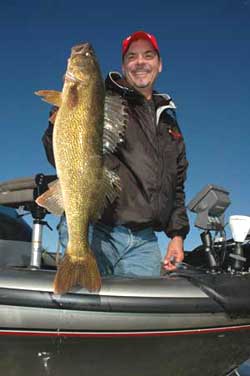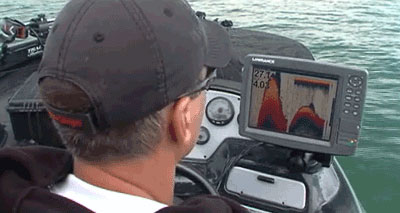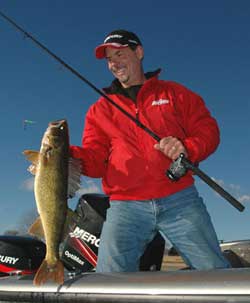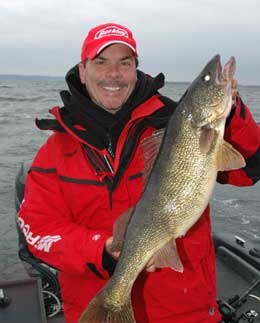 Change is not always a good thing in the world of walleye fishing … and fall is a time of many changes. Fish location and attitudes begin to change, the weather is unpredictable, and as a result, fishing can be tough … but not impossible! In fact, if you hit the water with the right game plan, it can be one of the best bites of the year!
Change is not always a good thing in the world of walleye fishing … and fall is a time of many changes. Fish location and attitudes begin to change, the weather is unpredictable, and as a result, fishing can be tough … but not impossible! In fact, if you hit the water with the right game plan, it can be one of the best bites of the year!
So why does this transitional time make walleye fishing tougher? The answer is fairly simple … a walleye adapts to his environment much quicker than fishermen do. Many anglers get into a fish catching rut during the summer period, when fish are active and their location is predictable. But throw in a few cool nights, and some fall-of-the-year weather fronts, and those "always there, always biting" walleyes pull a disappearing act. Especially on those warm fall days, even though it may feel like summer … the days have grown shorter, the nights a little longer, and if you don’t adapt to things, your livewell will be little more than a tub full of water … with no fish.
Keys to success this time of year begin with being observant. Pay attention to subtle differences in water temperature. On many lakes and reservoirs, a few degrees can be a big deal. It signals to the walleyes that it’s time for a move … a move toward structure. "But the walleyes on my lake are always on structure." you say. We’re talkin’ "on" structure … belly-on-the-bottom kind of "on". The movements are subtle … Fish that have been roaming large flats move just off the edge of the flat. Walleyes relating to points will tend to migrate to the sharper drops on the points, or zero in on specific structural elements of the points like rock piles, cups, and deeper shelves. Fish are less scattered but not necessarily bunched up. All these factors make them tougher to locate, so good searching skills become a primary advantage to anglers looking to score on these late summer fish.
 Since the general movement of the walleyes is to go deeper (15 feet and below), it actually becomes easier to spot fish using your electronics. The key is to know what to look for. Most of the time you won’t be marking fish separated from the bottom like you do when fish are active in the summer period. Instead of looking for "arcs", you will be scanning the bottom for "bumps". Now’s the time when a good locator can really pay for itself. Units like the Lowrance LCX-28C HD and LCX-113C HD that feature incredible resolution, color displays and power that allows an angler to see these "bumps" clearly on the bottom. Fish will show up as a little dark hump on the bottom, but definitely distinguishable from the standard bottom reading. A locator with fewer than 200 vertical pixels is not going to be capable of clearly showing these fish. The power output of the unit is important too. In water deeper than 30 feet, it will be tough to spot these "bumps" with anything less than 3000 watts peak-to-peak. The LCX-113C HD has a huge 600 vertical pixel color display and 4000 watts peak-to-peak power (using the standard 200 kHz transducer), and with that kind of high resolution, detecting these bottom huggers is no problem.
Since the general movement of the walleyes is to go deeper (15 feet and below), it actually becomes easier to spot fish using your electronics. The key is to know what to look for. Most of the time you won’t be marking fish separated from the bottom like you do when fish are active in the summer period. Instead of looking for "arcs", you will be scanning the bottom for "bumps". Now’s the time when a good locator can really pay for itself. Units like the Lowrance LCX-28C HD and LCX-113C HD that feature incredible resolution, color displays and power that allows an angler to see these "bumps" clearly on the bottom. Fish will show up as a little dark hump on the bottom, but definitely distinguishable from the standard bottom reading. A locator with fewer than 200 vertical pixels is not going to be capable of clearly showing these fish. The power output of the unit is important too. In water deeper than 30 feet, it will be tough to spot these "bumps" with anything less than 3000 watts peak-to-peak. The LCX-113C HD has a huge 600 vertical pixel color display and 4000 watts peak-to-peak power (using the standard 200 kHz transducer), and with that kind of high resolution, detecting these bottom huggers is no problem.
 While bottom hugging walleyes and tougher fishing conditions may make you think that catching these fish would call for slow, deliberate tactics like jigging and rigging, that’s not the case … not this early in the late season anyway. The walleyes are making subtle movements, but their attitude is still leaning toward "active", and although they are less scattered than before, they’re not as tightly congregated as they will be during the fall period. That means presentations like bottom bouncers and spinners, and trolling crankbaits are still top choices for catching these fish … you’ll just need to adapt your tactics to fit the situation.
While bottom hugging walleyes and tougher fishing conditions may make you think that catching these fish would call for slow, deliberate tactics like jigging and rigging, that’s not the case … not this early in the late season anyway. The walleyes are making subtle movements, but their attitude is still leaning toward "active", and although they are less scattered than before, they’re not as tightly congregated as they will be during the fall period. That means presentations like bottom bouncers and spinners, and trolling crankbaits are still top choices for catching these fish … you’ll just need to adapt your tactics to fit the situation.
Since you’re targeting fish that have moved a bit deeper, fishing spinners will call for using heavier bottom bouncers. A 1 ounce Bottom Bouncer may have worked just fine to fish spinners on the 10 to 12 foot flats in the summer, but you’ll want to go to a 2 ouncer to target fish that have dropped off the edge to 18 to 25 feet. A 3 ounce bouncer may be needed if the fish are on the bottom in 30 to 40 feet. Just be sure you match the tackle to the situation you’re fishing. In deeper water, a spinner needs a lot of flash to attract fish, and spinners using Bass Pro Shops XPS Walleye Angler Spinner Blades are a dynamite choice. These holographic blades emit a tremendous amount of flash and come in a great assortment of walleye catching colors, shapes and sizes.
 Trolling crankbaits is not usually thought of as a technique for tough fishing conditions, but this is a scenario where cranks can really shine. This is the time for contour trolling. It’s a game of precise boat control and lure placement. You have to know what depth the cranks are running to put them within a foot of the bottom, and then follow the depth contour where you’ve marked fish. This is where a technique such as trolling with lead core line and small cranks like Berkley’s 5mm sized Flicker Shad can be deadly. To learn more about this tactic, check out the article Trolling In Control – The Bottom Line on Trolling Lead Core – Part 2. This piece really lays out the details of contour trollinig with lead core and it’s a presentation you need to learn if you’re a serious walleye angler.
Trolling crankbaits is not usually thought of as a technique for tough fishing conditions, but this is a scenario where cranks can really shine. This is the time for contour trolling. It’s a game of precise boat control and lure placement. You have to know what depth the cranks are running to put them within a foot of the bottom, and then follow the depth contour where you’ve marked fish. This is where a technique such as trolling with lead core line and small cranks like Berkley’s 5mm sized Flicker Shad can be deadly. To learn more about this tactic, check out the article Trolling In Control – The Bottom Line on Trolling Lead Core – Part 2. This piece really lays out the details of contour trollinig with lead core and it’s a presentation you need to learn if you’re a serious walleye angler.
Keep in mind that this "movement" occurs primarily on inland lakes and reservoirs, and not as much on the Great Lakes where the walleyes have more of a tendency to suspend. However even those fish will make a discernible movement toward shallower water late in the season.
Autumn doesn’t have to signal the end of the season’s best fishing. It’s simply a time of transition, and in fact … some of the best fishing of the year is yet to come. But if you’re struggling to boat walleyes this time of year, consider whether or not you’ve adapted to the seasonal changes as well as the fish have … it may be just a matter of making a few minor changes and you’ll be back on track to catching your share of walleyes.










